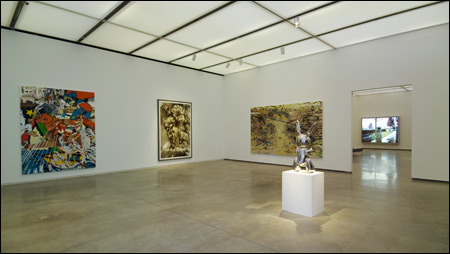Recently I was chatting with a local painter, whom I’ll call Picasso Menino, about Boston’s new Institute of Contemporary Art. The joint would be perfect, he quipped, if they just renamed it the Institute of Contemporary Picasso Menino Art.

LOCAL HERO: If Brookline photographer Maria Magdalena Compos-Pons can get a mid-career retrospective in Indianapolis, why not in the ICA’s expanded exhibition space? |
Like a lot of jokes, this one reveals a truth about what many local artists crave from the ICA as it decamps from the Back Bay for its flashy new digs on the South Boston waterfront. They wish the ICA were more engaged with Boston art.
Locals are energized by what the ICA’s move means: the stakes will be a lot higher. It’s a moment to dream big dreams. So I’ve conducted an unscientific survey of 16 local artists — ages 30 to 83, representing paintings, sculptures, films, videos, photographs, conceptual projects, and computerized installations — to get a sense of what the Boston art world is hoping for from the ICA at its moment of rebirth.
The ICA’s strength has always been the importing of work by top artists from outside this region, particularly foreign artists. Locals rave about the Carsten Höller show in 2003 and Thomas Hirschhorn’s transformation of the museum last year. “As an artist it’s really nice to be able to see that stuff there because you don’t see it anywhere else, of that caliber and that intelligence,” says Somerville sculptor Isabel Riley. The ICA has been a place where locals discover artists for the first time, like sculptor Cornelia Parker in 2000 and the Paul Chan video projection that was shown here in 2005 before landing in the Whitney Biennial. (Both artists are represented in the ICA’s new permanent collection.)
Locals look forward to more of this, but bigger and better, courting controversy, now that the museum has tripled its exhibition space and the capacity of its theater, is planning to expand its role in arts festivals, and has multiplied its programming of film, video, performance, art talks, and teen and family entertainment and education. They’re hoping the new museum will speak to a broader, less exclusive audience. But some worry that the ICA will take fewer risks as it grows, that it will show the same cadre of international art stars you see everywhere else.
Since 1999, the ICA has honored one local artist each year with an exhibition and a $5000 prize. Now the ICA Artist Prize will become biennial, and four finalists will show their work at the museum before the winner is chosen to receive $25,000. The switch is a hit: many artists believe that showing the finalists will emphasize the competitive nature of the award, spark lots of gossip and griping, attract greater attention, and so bring local contemporary art to more Bostonians.
Jill Medvedow, director of the ICA since 1998, points out that winning the ICA Prize in 2001 gave Boston sculptor Taylor Davis “a much wider national and international audience for her work” (she was subsequently included in the Whitney Biennial), and that the cash helped her buy equipment to make her work. “I think that sums up a lot of where I see the ICA doing significant work.”
This is the magic local artists hope the new ICA will do for many more of them when they call for the ICA to show more locals and be increasingly engaged here. (And they desperately hope that collectors notice.) The ICA’s ability to raise the stature of local artists rests in part on how local art mixes with work from out of town. Some say the ICA has presented local and out-of-town art equally, underlining their common achievement. Others believe that exhibitions like the ICA Prize ghettoize locals. They want more local artists in ICA surveys.
Medvedow argues that this is what the ICA has done by including Brookline photographer Maria Magdalena Compos-Pons in “Getting Emotional” (2005), Northampton painter and sculptor Richard Yarde in “Pulse: Art, Healing and Transformation” (2003), and several Bay Staters in “Collectors Collect Contemporary 1990-’99” (1999). Locals have also exhibited in the ICA’s Vita Brevis program, temporary public-art displays around Boston that are another way the ICA engages the city.
But as one artist said of the ICA Prize, “Is four artists every two years enough?” One might ask the same of the number of artists in ICA surveys. And what about major shows of local artists? In February the Indianapolis Museum of Art will open a mid-career retrospective of Compos-Pons. The exhibit has no New England venue.